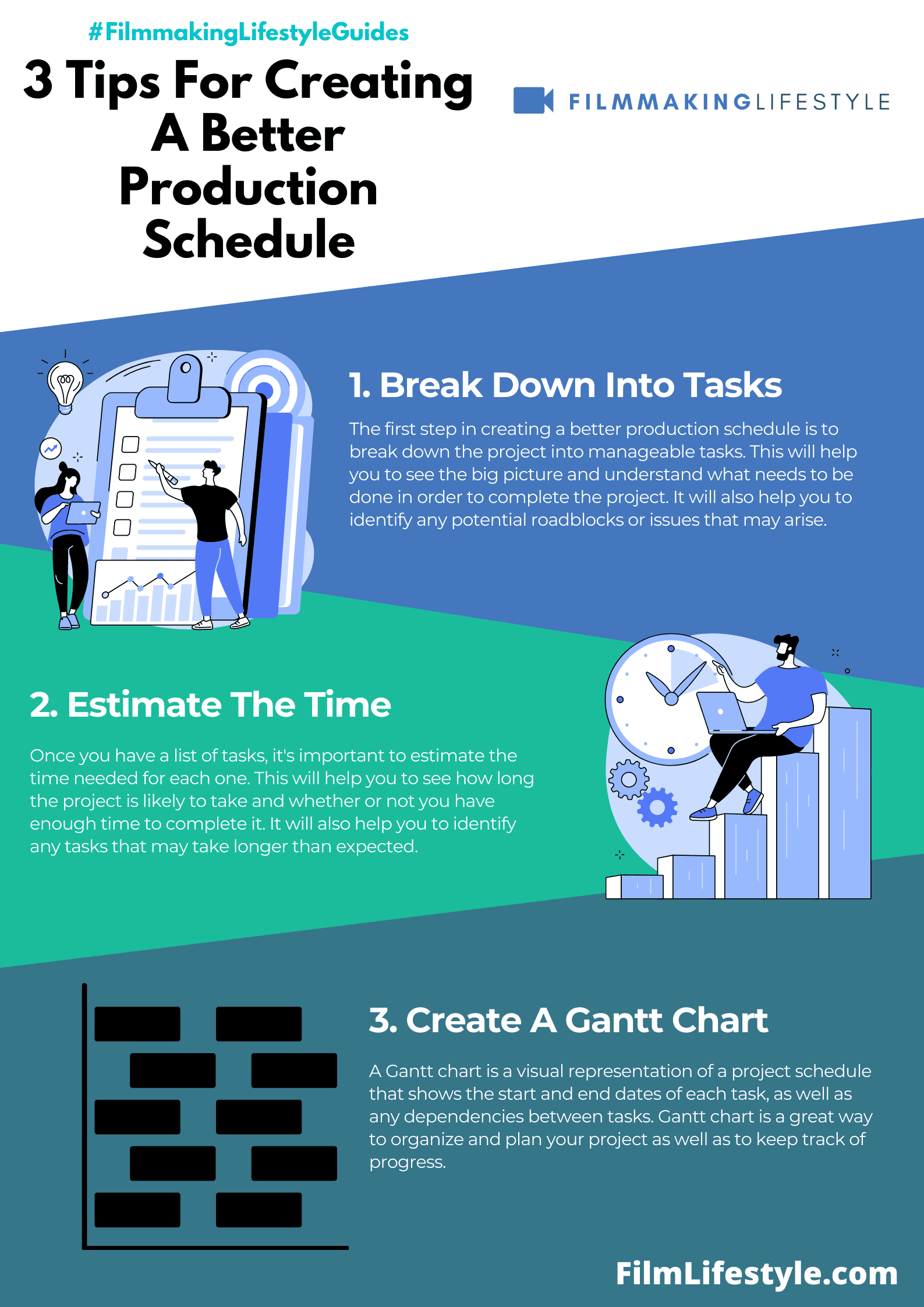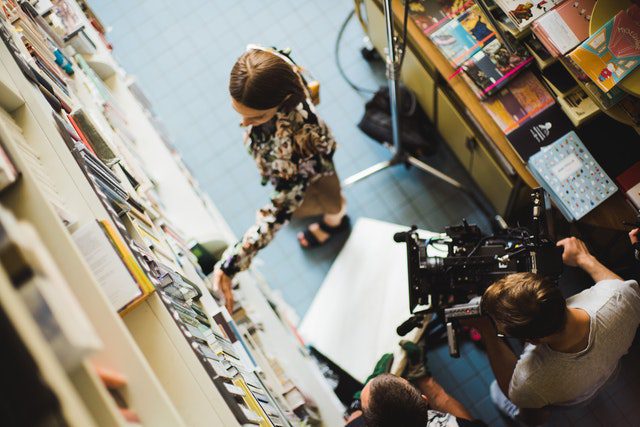Every director has to make a shooting schedule, and here is how you do it!
First, you need to look at the script and break down each scene by location. Find out when they will be in that location.
Second, count the number of scenes per day and find out how many hours there are in total for the days they will be filming at that location.
Divide this number by 8 hours if it’s not an even amount or 12 hours if it’s not an even amount.
Third, this will tell you how many minutes your scenes should last per day on set so that everything can fit within these time constraints, which means less time wasted on set and more time spent improving production quality!
We’ll show you how to make a shooting schedule. It’s really easy and super helpful if you’re on set!
PRODUCTION SCHEDULE
What Is a Production Schedule?
Production schedules are a way for filmmakers to track and organize their production.
Production schedules can be used as a tool to help make sure everything is going smoothly, but it also makes the process of filmmaking more time-consuming.
In the bustling world of filmmaking, a finely tuned production schedule is the heartbeat of any successful project.
It’s the roadmap that guides us from the chaos of pre-production to the final wrap, ensuring that every scene, actor, and resource is perfectly orchestrated.
We’ll jump into the intricacies of crafting a production schedule that not only keeps a film on track but also maximizes efficiency and creativity.
Whether you’re a seasoned producer or a first-time filmmaker, understanding the nuances of a well-structured production timeline is key to turning your cinematic vision into reality.
Join us as we unravel the secrets behind the scenes, exploring how a meticulous production schedule can make or break your film.
Get ready to take notes; we’re about to dive deep into the world of film production planning.
Importance Of A Production Schedule
A well-orchestrated production schedule is the lifeline that keeps the heart of a film project beating.
It’s the meticulously crafted plan that guides our team through pre-production, shooting, and post-production with precision and predictability.
Efficiency – one of the primary advantages of having a robust production schedule.
It helps us pinpoint where resources need to be allocated, ensuring that each day’s shoot is as productive as possible.
Financial Control becomes far more achievable with a well-structured schedule.
We can prevent overages, optimize budget allocation, and reduce unnecessary expenses, safeguarding us against financial pitfalls that plague so many productions.
Communication is streamlined when everyone is synchronized to a central schedule.
Confusion is minimized and we foster a more cohesive environment where every team member knows their role and timing.
Unexpected delays can often derail a production, but with a comprehensive schedule, we’re equipped to navigate these setbacks.
Schedules allow us to anticipate and adjust timelines, keeping us as close to on track as possible.
The benefits of productive schedules include:
- Maximizing Location Usage,
- Enhancing Crew Coordination,
- Improving Talent Management,
- Syncing with Post-Production Teams.
Crucially, schedules enable us to enhance the creative process.
With logistics handled, we can focus more on the artistic elements that make films memorable.
It allows us to allocate time for creativity rather than crisis management.
Creative aspirations can be fully realized when they’re not constantly interrupted by logistical challenges.
It’s here where schedules prove their worth – by providing a framework that supports artistic vision while maintaining practicality.
Pre-production Phase
Pre-production is a critical phase in filmmaking where the foundation for a successful shoot is built.
It involves meticulous planning and preparation to ensure the production phase runs smoothly.
During this stage, script breakdowns and storyboarding take center stage.
They allow us to visualize the film and pinpoint exactly what’s needed for each scene.
Casting decisions are made and key crew positions are filled during pre-production.
Our production team works tirelessly to find the perfect fit for every role, both in front of and behind the camera.
Location scouting becomes a priority – choosing the right settings is crucial for setting the tone and authenticity of a film.
Securing locations allows us to optimize our shooting schedule around them.
Budgeting and scheduling go hand in hand.
Pre-production is when we hammer out the financial details and establish a timeline that maximizes our resources.
Here’s a breakdown of the key components:
- Detailed script analysis,
- Storyboard creation,
- Casting and crew assembly,
- Location scouting,
- Budget drafting,
- Schedule construction.
Equipment and resource allocation also happen during this phase.
We’re assessing what we have, what we need, and the best ways to Use our assets.
Permit acquisition and legalities are sorted out to avoid any hiccups once filming commences.
We’re ensuring all our ducks are in a row well before we shout ‘Action!
‘
As we progress through pre-production, we’re continually refining our plans to adapt to new information and insights.
This adaptable approach is essential for a successful film production.
Creating A Shooting Schedule
Once the pre-production groundwork is laid, we jump into creating the shooting schedule.
This document serves as a critical blueprint for the entire production process.
The schedule is constructed around the scenes’ logistics – taking into consideration location availability, cast schedules, and the intricate timing of daylight or night scenes.
We factor in the continuity needs to ensure scenes are shot in an order that maintains the integrity of the story.
We start by organizing scenes into shoot days.
Shoot days are manageable blocks of time where we aim to film specific portions of the script.
Each day is carefully planned to maximize productivity and actor availability.
Navigating this complex puzzle requires a deep understanding of the script and the physical realities of production.
The elements that dictate our shooting schedule are diverse and detailed.
Here’s a brief look at what we encompass:
- Scene complexity,
- Cast requirements,
- Locations,
- Special equipment needs,
- External factors such as weather and permits.
Creating a shooting schedule isn’t just putting scenes on a calendar.
It’s an evolving process that demands regular updates.
As we encounter inevitable shifts in actor schedules or changes in location accessibility, our shooting schedule adapts.
It’s a live document that reflects our commitment to efficiency and adaptability.
Efficient scheduling triggers a ripple effect that reduces overtime and stress for the crew.
It increases our ability to maintain a high standard of safety and artistic quality throughout filming.
Our focus remains on crafting a film that is both a logistical and creative triumph.
Scheduling Resources And Personnel
Effective scheduling requires meticulous management of both resources and personnel.
Resource allocation includes everything from equipment to set pieces and plays a crucial role in determining the daily objectives.
Personnel management, on the other hand, involves coordinating the availability of cast and crew members.
Their schedules need to harmonize with scene requirements, ensuring the right people are on set at the right times.
Proper tracking of resources and personnel demands the use of specialized scheduling software.
These powerful tools allow us to:
- Adjust for unexpected changes effortlessly,
- Share updates in real-time with all stakeholders,
- Minimize conflicts between various departmental needs.
Beyond software, it’s also vital to have a dedicated scheduling team.
This team is often led by the assistant director who is tasked with:

- Overseeing day-to-day operations,
- Managing the shooting schedule intricately,
- Liaising between the director and the production coordinator.
Our experience tells us that flexibility within the filming schedule is essential.
Variables such as weather conditions or actor availability can shift without notice, and our schedules must account for these potential fluctuations.
To maintain an efficient production, we keep a keen eye on the following:
- The physical well-being of cast and crew,
- Contingency plans If delays,
- Clear communication channels to disseminate schedule changes quickly.
By balancing these elements, we stay on track without compromising the artistic vision of the film.
We recognize that a well-orchestrated schedule is as much an art as it is a science, reflecting the dynamic nature of film production.
Adapting The Schedule During Production
Adapting to changes during film production is inevitable.
As each day unfolds, unexpected challenges can arise which require swift alterations to the schedule.
Unpredictable weather can wreak havoc on an outdoor shoot planned weeks in advance.
This may necessitate a complete reshuffling of scenes to accommodate for indoor filming or finding an alternative location.
Sometimes, a key cast or crew member may fall ill or be unable to attend.
In such situations, it’s crucial that we have backup plans in place, ensuring the day’s shoot isn’t completely lost.
Technical difficulties are also a part of the filming landscape.
Whether it’s a malfunctioning camera or a glitch in the sound equipment, our readiness to tackle these hiccups head-on keeps the production moving.
Adjustments may not just stem from setbacks.
There might be an opportunity to capture a scene in an even more compelling manner than originally envisioned.
Here are some steps we take to adapt the schedule creatively and efficiently:
- Assess the impact of the change on the current schedule,
- Consult with key department heads for quick decision-making,
- Communicate the changes to all involved parties promptly,
- Ensure that safety and quality are not compromised in the rush.
By staying agile and fostering a collaborative environment, we embrace change rather than fear it.
eventually, adapting our schedule during production isn’t merely about staying on track – it’s about optimizing our time and resources to enhance the film’s creative potential.
Production Schedule In Film – Wrap Up
Mastering the art of production scheduling is a dynamic process that can make or break a film project.
We’ve seen how crucial it is to remain flexible and responsive to the ever-changing landscape of film production.
Our readiness to adapt, coupled with a robust strategy, ensures we’re always a step ahead, turning potential setbacks into opportunities for creative ingenuity.
Let’s carry these insights forward, knowing they’re the key to unlocking the full creative potential of our next cinematic venture.
Together, we’ll craft not just schedules but stories that truly resonate.
Frequently Asked Questions
What Is The Main Focus Of The Article?
The article centers on the importance of flexibility in film production scheduling to cope with unforeseen challenges and optimize the creative potential of the film.
Why Is Adjusting The Film Production Schedule Important?
Adjusting the film production schedule is important to manage unexpected events like bad weather, illness, or technical issues, ensuring the film’s quality and timely completion.
What Kind Of Challenges Can Affect A Film Production Schedule?
Challenges that can impact the schedule include unpredictable weather, health-related absences of the cast or crew, and technical difficulties with equipment or sets.
How Can Film Producers Prepare For Unforeseen Challenges?
Producers can prepare by having contingency plans, being ready to make swift decisions, and maintaining a flexible mindset to adapt the schedule as needed.
What Are The Benefits Of Having A Flexible Schedule In Film Production?
A flexible schedule allows for the accommodation of unexpected events, the potential for more creative scene captures, and the optimization of both time and resources.
What Should Be Done To Adapt The Schedule Creatively And Efficiently?
To creatively and efficiently adapt the schedule, proactive planning should be combined with a readiness to pivot and innovate in response to new circumstances.





